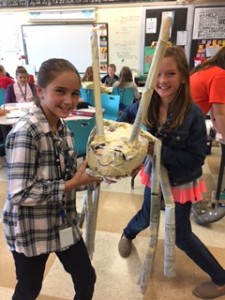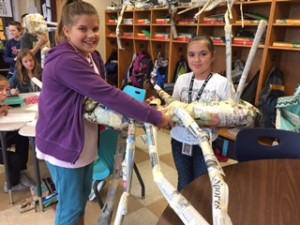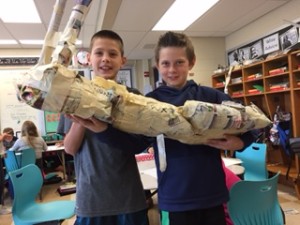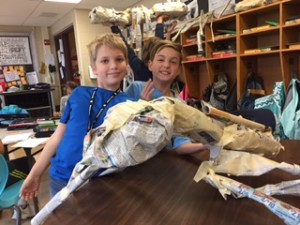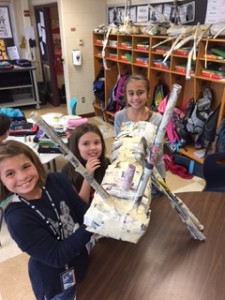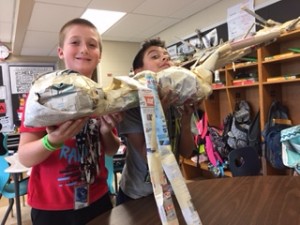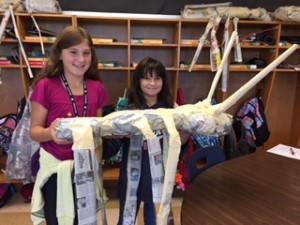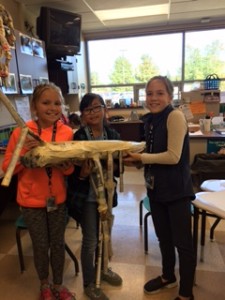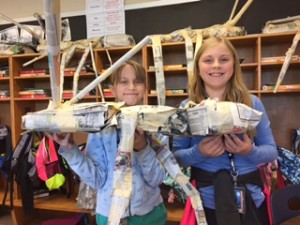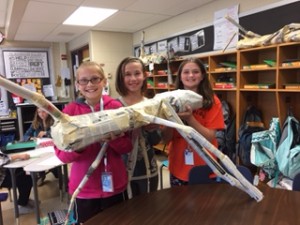We have finished out giant ants! Students had an awesome time calculating how big an ant would be if it was 100 times its normal size. Then they measured and made a giant ant to go with their calculations. Even more exciting…some may be coming home to your home!
Category Archives: Math
Math Units
These are the math units we will be covering this year.
Unit 1: Whole Number and Decimal Fraction Place Value to the One-Thousandths
At the end of this unit, students will be able to independently use their learning to:
- Demonstrate an understanding that in a multi-digit number, a digit in one place represents 1/10 of what it represents in the place to its left
- Explain patterns in the number of zeroes in the product when multiplying a number by powers of 10 (scientific notation/exponential notation)
- Explain patterns in the placement of the decimal point when a decimal is multiplied or divided by a power of 10
- Use whole number exponents to denote powers of 10
- Read and write decimals to thousandths using base 10 numerals, word form, and expanded form
- Compare two decimals to thousandths based on meanings of the digits in each place, using >, =, and < symbols
- Round decimals to ones, tenths, hundredths, or thousandths place
- Convert among different sized measurement units within a given measurement system using a provided table of equivalencies.
Unit 2: Multi-digit Whole Number and Decimal Fraction Operations
At the end of this unit students will be able to independently use their learning to:
- Multiply multi-digit whole numbers, not to exceed three digits by three digits
- Find whole number quotients of whole numbers with up to four digit dividends and two digit divisors
- Add, subtract, multiply, and divide decimals to hundredths (no divisors with decimals)
- Use multiple grouping symbols (parentheses, brackets, or braces) in numerical expressions, and evaluate expressions containing these symbols
- Write simple expressions that model calculations with numbers
- Interpret numerical expressions without evaluating them
Unit 3: Addition and Subtraction of Fractions
At the end of this unit, students will be able to independently use their learning to:
- Add and subtract fractions (including mixed numbers) with unlike denominators
- Solve problems using computation of fractions by using information presented in line plots
Unit 4: Multiplication and Division of Fractions and Decimal Fractions
At the end of this unit, students will be able to independently use their learning to:
- Solve word problems, including division of whole numbers, leading to answers in the form of fractions
- Multiply a fraction and mixed numbers by a fraction
- Demonstrate an understanding of multiplication as scaling/resizing
- Divide unit fractions by whole numbers and whole numbers by unit fractions
- Convert among different sized measurement units within a given measurement system using a provided table of equivalencies
- Solve problems involving computation of fractions by using information presented in line plots
- Display and interpret data shown in tallies, tables, charts, pictographs, bar graphs, and line graphs
- Display and interpret data using the title, appropriate scale, and labels
Unit 5: Addition and Multiplication with Volume and Area
At the end of this unit, students will be able to independently use their learning to:
- Classify two dimensional figures in a hierarchy based on properties
- Apply the formulas V = l x w x h and V = B x h for rectangular prisms to find volumes of right rectangular prisms with whole number edge lengths in the context of solving real world and mathematical problems given the appropriate formula
- Find volumes of solid figures composed of two non-overlapping right rectangular prisms
Unit 6: Graph Points on Coordinate Plane to Solve Problems
At the end of this unit, students will be able to independently use their learning to:
- Generate two numerical patterns using two given rules
- Identify apparent relationships between corresponding terms of two patterns with the same starting numbers that follow different rules
- Identify parts of the coordinate plane (x-axis, y-axis, and the origin) and the ordered pair (x-coordinate and y-coordinate). Limit the coordinate plane to quadrant I
- Represent real-world and mathematical problems by plotting points in quadrant I of the coordinate plane, and interpret coordinate values of points in the context of a situation
- Solve problems involving computation of fractions by using information presented in line plots
- Display and interpret data shown in tallies, tables, charts, pictographs, bar graphs, and line graphs
- Display and interpret data using a title, appropriate scale, and labels
